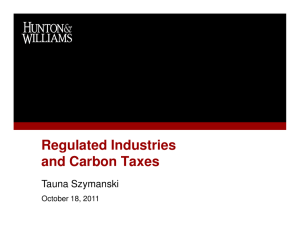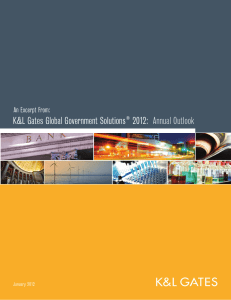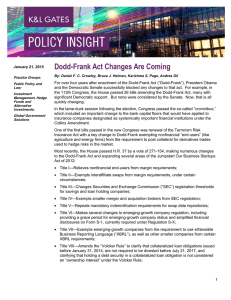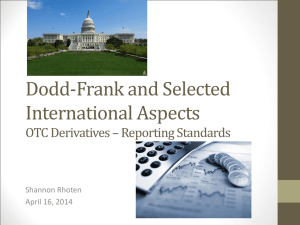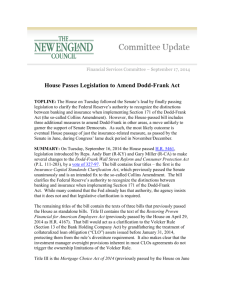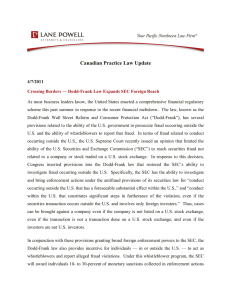“P O C
advertisement
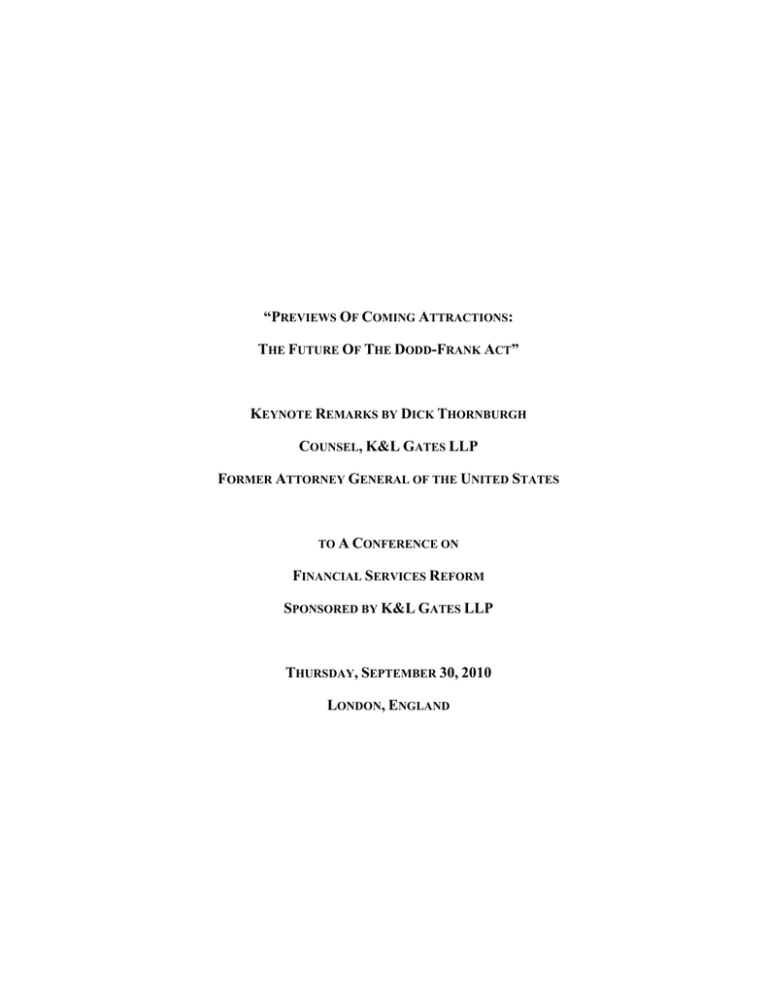
“PREVIEWS OF COMING ATTRACTIONS: THE FUTURE OF THE DODD-FRANK ACT” KEYNOTE REMARKS BY DICK THORNBURGH COUNSEL, K&L GATES LLP FORMER ATTORNEY GENERAL OF THE UNITED STATES TO A CONFERENCE ON FINANCIAL SERVICES REFORM SPONSORED BY K&L GATES LLP THURSDAY, SEPTEMBER 30, 2010 LONDON, ENGLAND INTRODUCTION It is difficult to overstate the significance to the future of the financial services industry of the current reform efforts in the U.S., the U.K., and the European Community. As you know, in the United States, the Dodd-Frank Wall Street Reform and Consumer Protection Act was recently enacted into law. The Dodd-Frank Act, as it is known, represents the most significant reshaping of the U.S. legal and regulatory landscape for the financial services industry since the Great Depression. In a very real sense, Congress revisited every major financial services law since the National Bank Act was passed in 1864. However, as we shall see, much of the work remains to be done. This afternoon you will hear and learn a great deal about this legislation. But I want first to pause just a moment to consider what the bill is not. Although the new law is dramatic, it could have been much more draconian in its impact. DEVELOPMENT OF LEGISLATION The Dodd-Frank Act was developed in response to the global financial crisis of 2008, from which nations are still recovering two years later. It is widely agreed that the financial crisis had its roots in the U.S. subprime mortgage market. A bubble in the housing market caused lenders to relax their exercise of prudence. As the housing market cooled in 2006, there were unexpected losses caused by rising foreclosures and bad loans. By 2008, some of the most venerable financial institutions were shown to be vulnerable to liquidity runs. Large financial institutions on both sides of the Atlantic found themselves severely undercapitalized and possessed of insufficient liquidity. As the short-term credit market froze, many of these institutions declared bankruptcy or had to be rescued financially. The value of complex, securitized financial instruments became uncertain. As market participants lost confidence, countries headed towards a possible Depression. In what was really a triumph of reality over ideology, governments around the world took unprecedented actions to stave off calamity. The result was “only” what we are now calling the Great Recession. 2 With the benefit of 20/20 hindsight, it is widely believed that government failed to do its job in reviewing and regulating the private financial markets. In the U.S., to be somewhat simplistic, a lack of adequate attention coupled with a patchwork of existing financial regulatory agencies resulted in gaps, overlaps, and lack of coordination, resulting, in turn, in failure to detect or moderate systemic risks to the financial system. The cries for reform began almost immediately. In March 2008, the Bush Administration – not exactly a liberal, leftist, interventionist Administration – called for modernizing the financial regulatory structure, including merging the SEC and Commodities Future Trading Commission. But reform efforts really heated up after that year’s presidential election. In May 2009, the highly-regarded Committee on Capital Markets Regulation recommended creating a new agency, similar to the U.K.’s Financial Services Authority, to regulate all aspects of the financial system. In June 2009, the Obama Administration unveiled its Financial Regulatory Reform Plan, billed as “a new foundation for financial regulation and supervision.” It proposed consolidating all bank regulators into one National Bank Supervisor. But, in the end, these more radical proposals were not adopted. Instead, legislation designed to address regulatory failure did so by proposing more regulation. A lot more regulation. And Congress addressed criticism of existing agencies by eliminating the grand total of only one agency, shuffling responsibilities among the others, and ordering them all to work together. The House of Representatives passed its bill in December of 2009 and the Senate followed with its version in May of this year. The two bills were reconciled and President Obama signed the new law on July 21, 2010. With that backdrop, let me highlight a few areas that were reformed, give you an overview of potential next steps and international implications, and some thoughts on the consequences of these efforts to financial firms in the U.S. and abroad. Significantly, I hope that you will keep in mind that much remains to be done to 3 implement the new law, and that financial firms that actively engage with the government may, in fact, provide themselves with a competitive advantage. THE DODD-FRANK ACT First, let’s turn to some of the specifics of the U.S. reform effort. As in Europe, the focus in the U.S. has been on the regulation of systemic risk, filling regulatory gaps, and expanding enforcement mechanisms. I will briefly describe just a few of the many, many provisions set forth in the Act’s 2,319 pages. The Act creates a Financial Stability Oversight Council or FSOC, similar to the European Systemic Risk Board, with broad authorities aimed at monitoring and identifying systemic risks to financial markets. Under this regime, both bank and nonbank financial companies – including foreign nonbank financial companies – may be placed under supervision and be subject to more stringent prudential standards and capital and risk requirements. Dodd-Frank also establishes a liquidation authority for winding down covered financial companies. Notably, the Act creates entirely new regulatory frameworks to govern advisers to hedge funds and other types of private funds, as well as OTC derivatives, in parallel to the EU negotiations on the Alternative Investment Fund Managers’ Directive. DoddFrank generally requires private fund advisers, with certain exceptions, to register with the SEC and subjects them to recordkeeping and reporting requirements related to the private funds they advise. There is an exemption for certain foreign private fund advisers if the total amount of assets they manage for their clients and funds is less than $25 million. The new regulatory regime for the OTC derivatives market requires clearing and exchange-trading of certain swaps and security-based swaps. As a result of the socalled Lincoln Rule, the Act requires banks to spin-off their swap trading desks into separate, capitalized affiliates, with certain exceptions for hedging and other similar risk-mitigating activities with respect to the bank’s own risk. 4 Under Dodd-Frank, depository institutions and their holding companies will face new supervisory regulators, increased activities restrictions and capital requirements, and numerous other fundamental changes in how they are regulated. For example, under the so-called Volcker Rule, banks are prohibited from engaging in proprietary trading or sponsoring or owning an equity interest in a hedge fund or private equity fund. The objective of these reforms is to return to the traditional model of banking, reversing the trend toward consolidation of commercial banks, investment banks, securities firms, and insurance companies. Also notably, the Act imposes a general concentration limit on all financial companies, in an effort to thwart the “too big to fail” argument. These provisions prohibit any acquisition that would result in a financial company having more than 10 percent of the aggregate consolidated liabilities or insured deposits of all financial companies. One of the areas of partisan contention during the development of the legislation was the issue of consumer financial protection. The Act establishes a Bureau of Consumer Financial Protection or CFPB, to be housed within the Federal Reserve Bank. Similar to the consumer protection functions of the Consumer Protection and Markets Authority proposed by Chancellor Osborne, the CFPB will have authority for consumer protection with respect to financial products and services offered by both banks and nonbanks, including broad rule-making authority, as well as examination and enforcement authority over large depository institutions and nonbank financial institutions for compliance with consumer protection laws. Dodd-Frank also contains numerous provisions designed to reform the Securities and Exchange Commission, give it new enforcement powers and to protect investors. A few examples will demonstrate the reach of these provisions. For one, the Dodd-Frank Act authorizes bounty payments to those who provide “whistle-blower” information to the SEC that leads to a successful enforcement action. Dodd-Frank also provides for U.S. jurisdiction over actions brought by the SEC relating to securities transactions outside the U.S. where the defendant took “significant steps” in the U.S. to 5 further the violation, or if the foreign misconduct had a “foreseeable substantial effect” within the U.S. Additionally, the Act expands liability under the securities laws to include anyone who “knowingly or recklessly provides substantial assistance” in violating the statute or regulation. One of the most controversial investor protection measures is the possibility of imposing a fiduciary duty on broker-dealers. Rather than resolving this matter, the Act “kicked the can down the road” by calling for a study by the SEC, and possible rulemaking, as to what the standards of care should be for brokers, dealers, and investment advisers who provide personalized investment advice to retail customers. The Dodd-Frank Act also puts in place a regulatory regime to oversee credit rating agencies known as nationally recognized statistical rating organizations or NRSROs. Interestingly, there are specific provisions in the Dodd-Frank Act that remove statutory and regulatory references to NRSROs, which may have the impact over time of decreasing reliance on credit rating agencies. In the area of corporate governance, Dodd-Frank importantly authorizes the SEC to determine the terms and conditions of providing proxy access to shareholders, which could possibly lead to requiring public companies to bear the costs of shareholder activism. With respect to executive compensation, the Act directs the SEC to promulgate rules providing shareholders of public companies with an advisory vote on executive compensation, also known as a “say on pay.” LOOKING AHEAD Let’s turn now to the issue of next steps and international developments. On many issues, the Dodd-Frank Act provides merely a framework, to be filled in by regulators. Congress left many of the most controversial and important policy decisions to rulemaking or study by a spate of administrative agencies. 6 Particularly important for our discussion today, this process may be further impacted by international efforts. The recent crisis underscored the interdependence of today’s complex financial markets. In recognition of this, in November 2008, the G-20 pledged to pursue extensive regulatory reforms, including the creation of new international regulatory standards and national level reforms. Since that time, the G-20 has met three times, with the participating countries continuing to make agreements to coordinate and harmonize policy responses. Another notable international development was the agreement reached on September 12 by the central bank governors of 27 countries on new capital requirements for the banking sector, which is becoming known as Basel III. The agreement requires banks to sharply increase minimum capital requirements, in order to increase the buffer available in the case of future crises. Consistent with the proposed G-20 timeline, the requirements will be phased in beginning in 2013 and become fully effective by 2019. CONSEQUENCES As we will be discussing today, the breadth of the Dodd-Frank Act is wideranging, extending to most parts of the financial services industry. Some of the reforms will dramatically reshape the industry itself. Getting “too big” will have consequences. The Act goes so far as to put limits on depository institution growth and aims to prevent consolidation across financial sectors. In this environment, smaller financial institutions may have certain regulatory advantages. The Act dramatically reduces the number of unregulated financial firms and products, such as hedge funds and OTC derivatives. This will change the competitive dynamics between various investment vehicles. For example, mutual funds will be competing on more level regulatory terrain with private funds and hedge funds. Institutional investors in previously unregulated products may find themselves attracted to funds that are more accustomed to operating in a regulated environment. Further, innovations such as the Volcker Rule may benefit currently registered products, such as 7 mutual funds, as depository institutions and their holding companies seek investment alternatives. In addition to these macro-level consequences, the day-to-day operational issues may have a larger impact on those here today. The new legal and regulatory structure will, of course, be associated with significant additional costs to financial firms. Financial firms, particularly in certain sectors, will undoubtedly incur increased compliance costs as a result of Dodd-Frank’s new regulatory burdens. In some cases, these regulatory burdens and costs may result in barriers to entry and possibly consolidation within financial sectors as firms grapple with these costs. In today’s global markets, capital moves freely across borders and time zones. One might ask whether reforms in the U.S. will simply drive financial activity elsewhere. It has been suggested that if banks in New York or Charlotte are prohibited from running swaps trading desks, perhaps those trades will be executed by banks in Switzerland. To that, I have two reactions. First, U.S. policy makers have made clear that they will utilize any means at their disposal, including limiting access to U.S. markets for firms that seek to evade prudential regulation. Second, international bodies such as the G-20, the Financial Stability Board and the Basel Committee on Banking Supervision are playing an unprecedented role in seeking to coordinate and harmonize global financial regulation. Let me make a final point. While it is certain that the reform effort will result in increased burdens and costs, there may also be opportunities to lessen the impact and even to possibly garner benefits. These opportunities extend to financial firms based abroad. Remember, the Dodd-Frank Act is a work in progress and, in fact, is largely incomplete. The Dodd-Frank Act is merely a legislative framework, to be filled out by the regulatory agencies through regulation, guidance and enforcement. There are going to be significant opportunities for stakeholders, including individual financial firms, to influence the outcome of these processes. There are 8 several reasons for this. The first is the sheer magnitude of undertaking the at least 315 rulemaking and the 145 studies required by the Act. Moreover, these rulemakings and studies will address extremely technical areas, the outcome of which may have dramatic and sometimes unforeseen consequences in the real world. The regulatory agencies charged with these rulemakings and studies are already under-staffed and underresourced, so they are likely to solicit and rely heavily on outside input. As a result, stakeholders will have the opportunity to influence decision-makers and shape the outcome of the reform efforts – in many cases to ameliorate the impact of Dodd-Frank on their business operations and perhaps even to provide a benefit. Additionally, the legislative and regulatory processes are likely to interact in a complex manner. Congress retains a vested interest in the outcome of these issues. As a result, the rulemaking process will be subject to ongoing Congressional oversight and scrutiny, both formal and informal. And if, as currently predicted, the Republicans gain a majority in either the House or the Senate this November, Congressional activity will be even greater. Finally, in the case where U.S. provisions conflict with those abroad, the perspective of foreign regulators may help inform the Dodd-Frank implementation discussion. CONCLUSION There can be no doubt that Dodd-Frank Act does significantly reconfigure the legal and regulatory framework for the financial services industry. That said, much work remains to be done and there will no doubt be a role for financial firms to engage with decision-makers and help to shape the final outcome. I urge you to take full advantage of such opportunities. Thank you. 9
